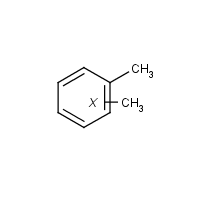Xylene isomers
Agent Name
Xylene isomers
Alternative Name
Dimethylbenzene
CAS Number
1330-20-7; 95-47-6; 108-38-3; 106-42-3
Formula
C8-H10
Major Category
Solvents

Synonyms
Benzene, dimethyl-; Dimethylbenzene; Ksylen [Polish]; Methyl toluene; Methyltoluene; Violet 3; Xiloli [Italian]; Xylenen [Dutch]; Xylenes; Xylol; Xylole [German]; [ChemIDplus]; includes m-xylene (108-38-3), o-xylene (95-47-6), p-xylene (106-42-3); UN1307
Category
Aromatic Solvents
Description
Colorless liquid with an aromatic odor; [NIOSH]
Sources/Uses
Used as a solvent in paints, coatings, and rubber cement; used as a chemical intermediate; [ACGIH] Used in photography (color retouching); [www.ci.tucson.az.us/arthazards/medium.html] In semiconductor manufacturing, xylene is used to "develop" the pattern in the photoresists; [CHS, p. 44]
Comments
Temporary memory loss, confusion, and laboratory evidence of liver injury have been reported in workers overexposed to xylene. 2021 TLV Basis: eye irritation, irritation of upper respiratory tract, hematological effects, ototoxicity (for p-xylene), CNS impairment; [ACGIH] There is limited evidence that xylene can increase spontaneous abortions in exposed workers and birth defects in experimental animals. [ATSDR Case Studies #29] Xylene is in the list of "Some volatile substances which may be abused by inhalation" published on the web site of the U.N. International Drug Control Programme, indicating its potential to cause narcosis in workers. [Flanagan et al. Volatile Substance Abuse] A skin and eye irritant; Inhalation of high concentrations may cause CNS effects; [ICSC] Causes contact urticaria; [Kanerva, p. 219]
Reference Link #1
Biomedical References
Exposure Assessment
BEI
Xylenes (technical or commercial grades): 0.3 g/g creatine methylhippuric acids in urine at end of shift; [ACGIH TLVs and BEIs]
Skin Designation (ACGIH)
No
TLV (ACGIH)
20 ppm
STEL (ACGIH)
150 ppm
PEL (OSHA)
100 ppm
MAK
100 ppm
IDLH (NIOSH)
900 ppm
Excerpts from Documentation for IDLHs
It has been reported that 1,000 ppm for 5 minutes or less will probably allow selfrescue with no irreversible injury [ANSI 1971]. Volunteers found 200 ppm to be definitely irritating to the eyes, nose, and throat [Nelson et al. 1943]. Reaction time was not affected in 23 volunteers exposed to 100 or 200 ppm for 3 to 7 hours [Ogata et al. 1970]. No noticeable changes in reaction time or shortterm memory tests were seen in 15 volunteers exposed to 100 or 300 ppm for 70 minutes [Gamberale et al. 1978].
Vapor Pressure
6.5 mm Hg
Odor Threshold Low
0.08 ppm
Odor Threshold High
40 ppm
RD50
1467 ppm
Lethal Concentration
LC50 (rat) = 5,000 ppm/4H
Explanatory Notes
Detection odor threshold from AIHA (mean = 20 ppm); The exposure limits apply to all isomers. VP = 6.65-8.80 mm Hg @ 25 deg C; [HSDB]
Half Life
Whole body: 20-30 hours (longer if significant fat deposition); [TDR, p. 1236]
Reference Link #2
NFPA
may ignite at ambient temp
Adverse Effects
Neurotoxin
Acute solvent syndrome
Hepatotoxin
Hepatoxic (a) from occupational exposure (secondary effect) or (b) in animal studies or in humans after ingestion
Reproductive Toxin
Yes
IARC Carcinogen
Not classifiable
ACGIH Carcinogen
Not Classifiable
Diseases, Processes, and Activities Linked to This Agent
Diseases
Occupational diseases associated with exposure to this agent:
Processes
Industrial Processes with risk of exposure:
Activities
Activities with risk of exposure: